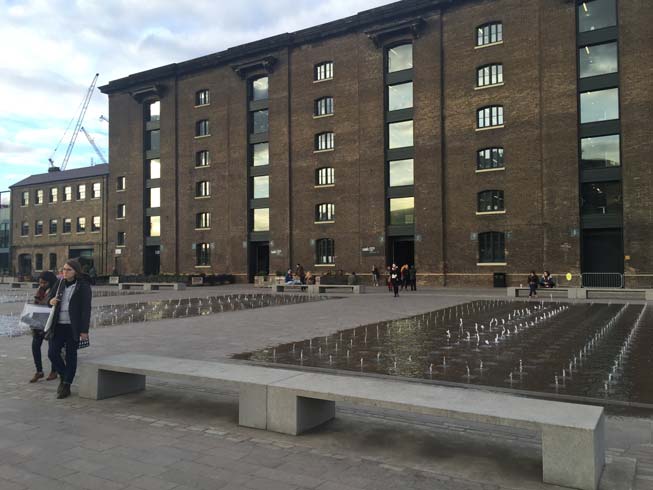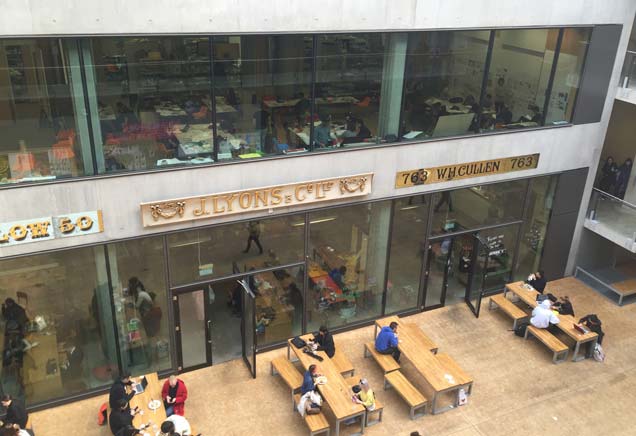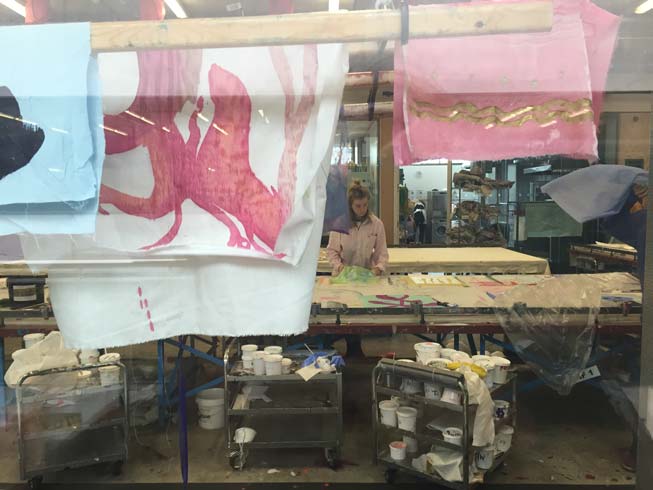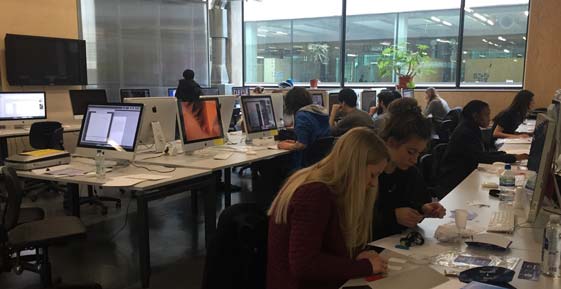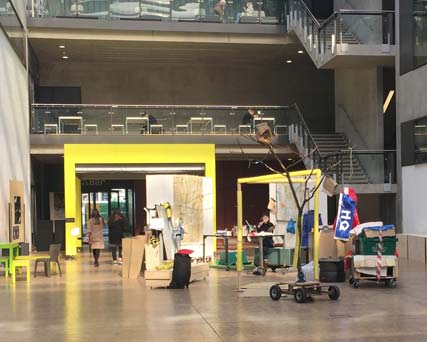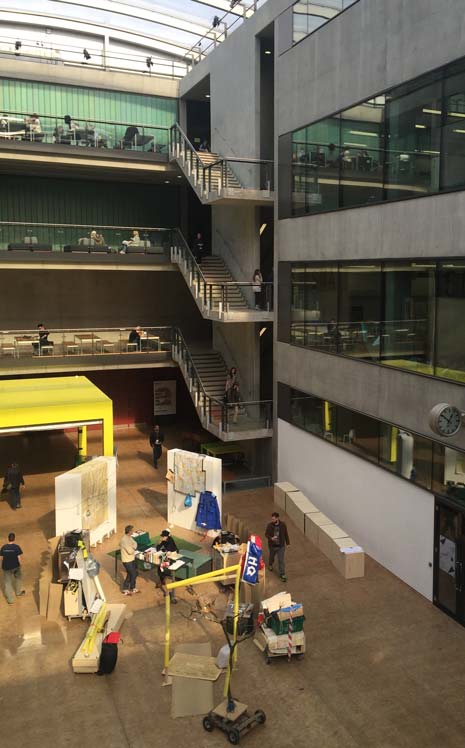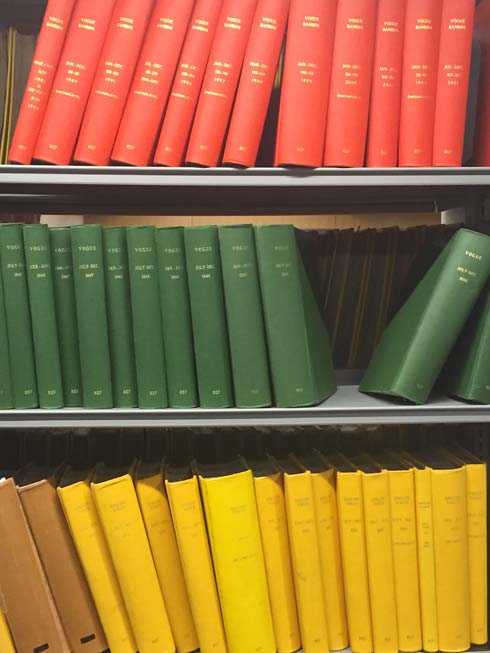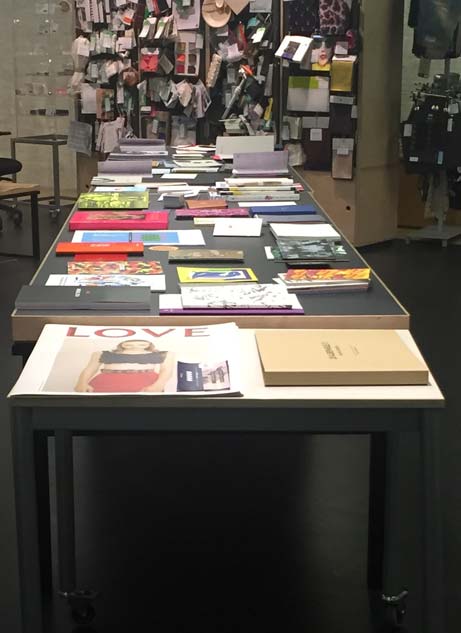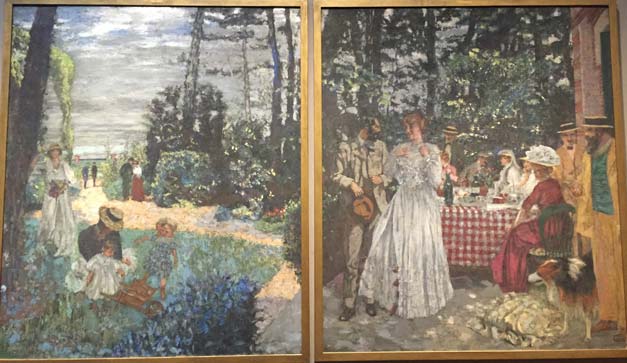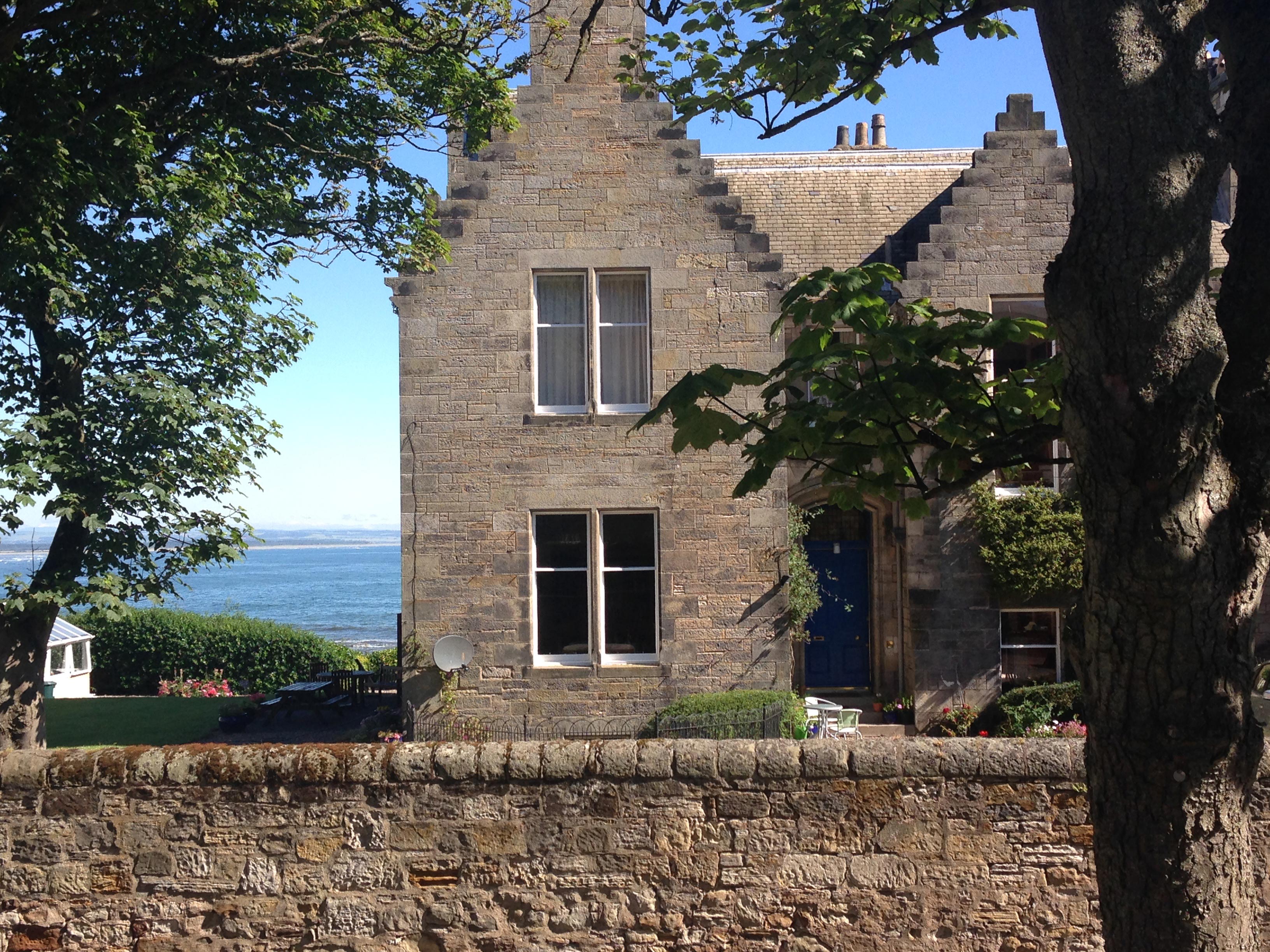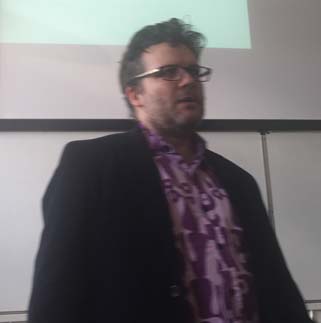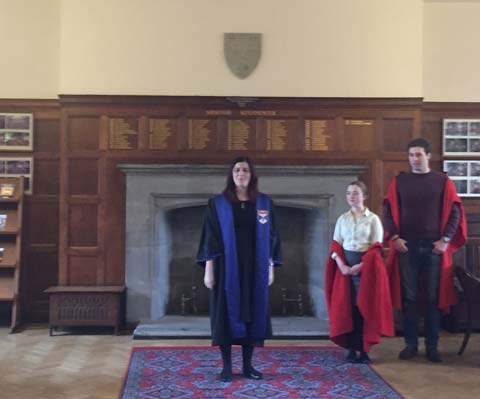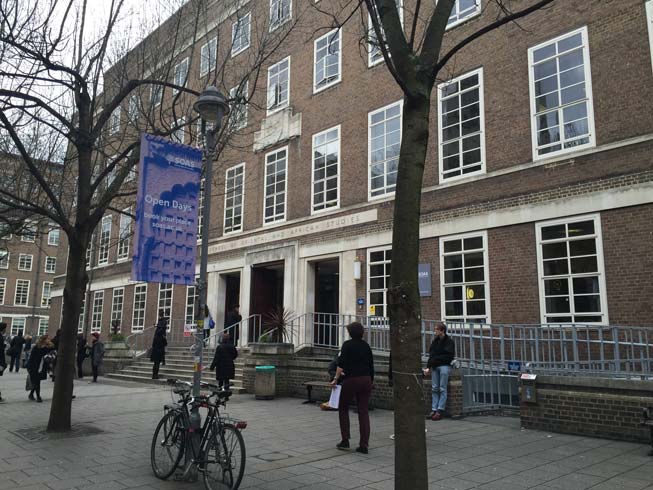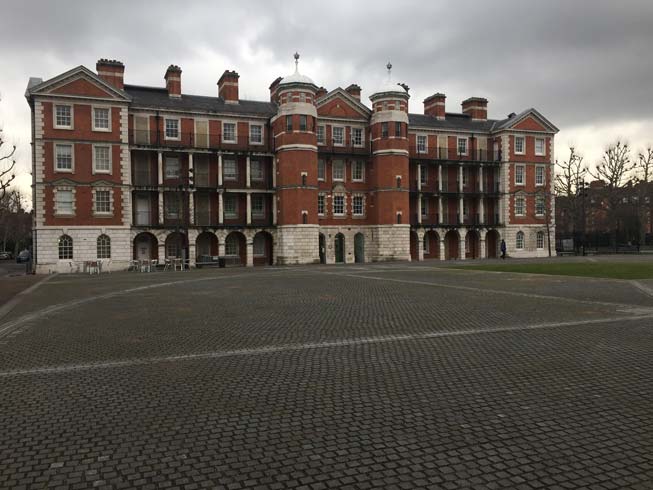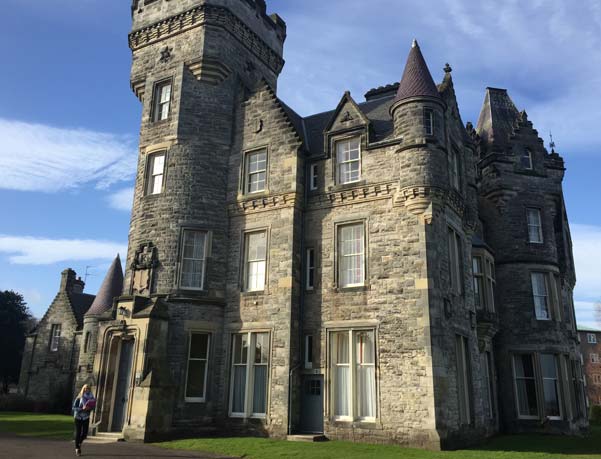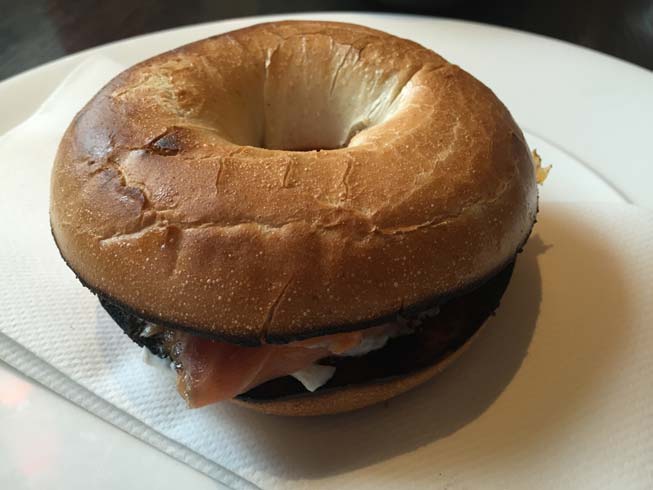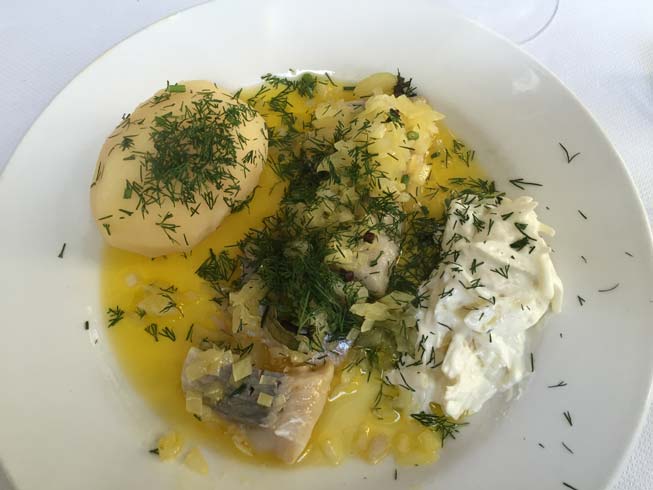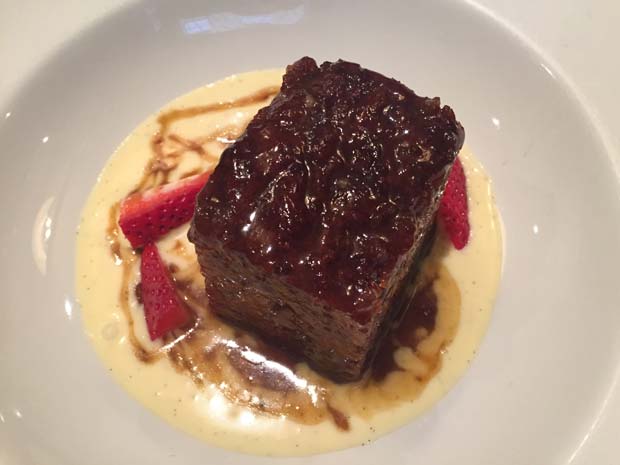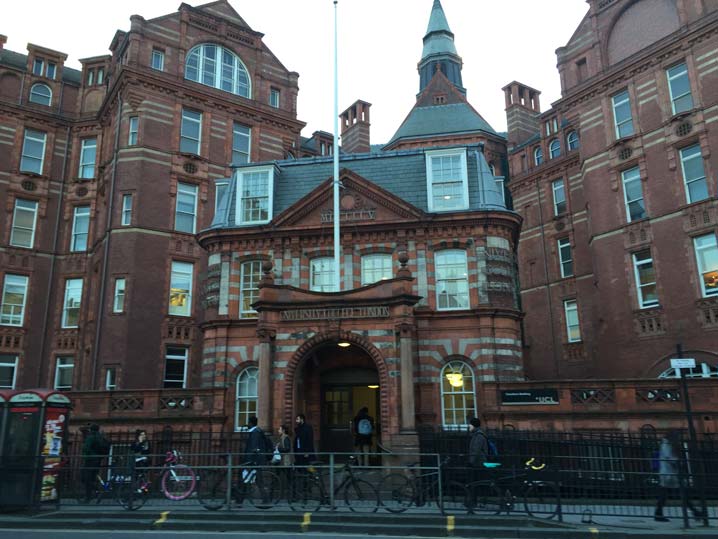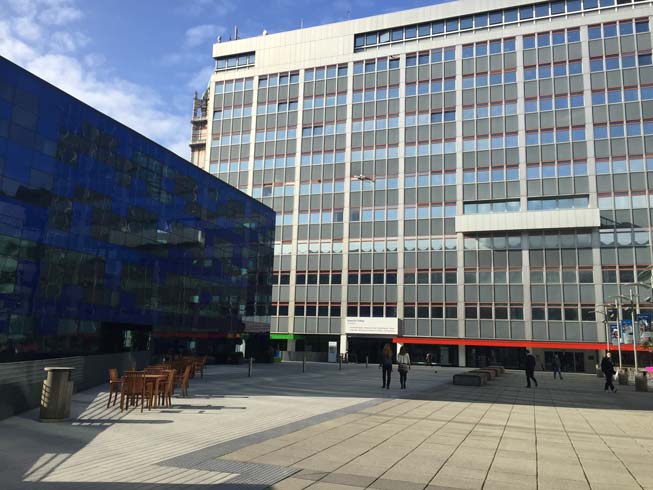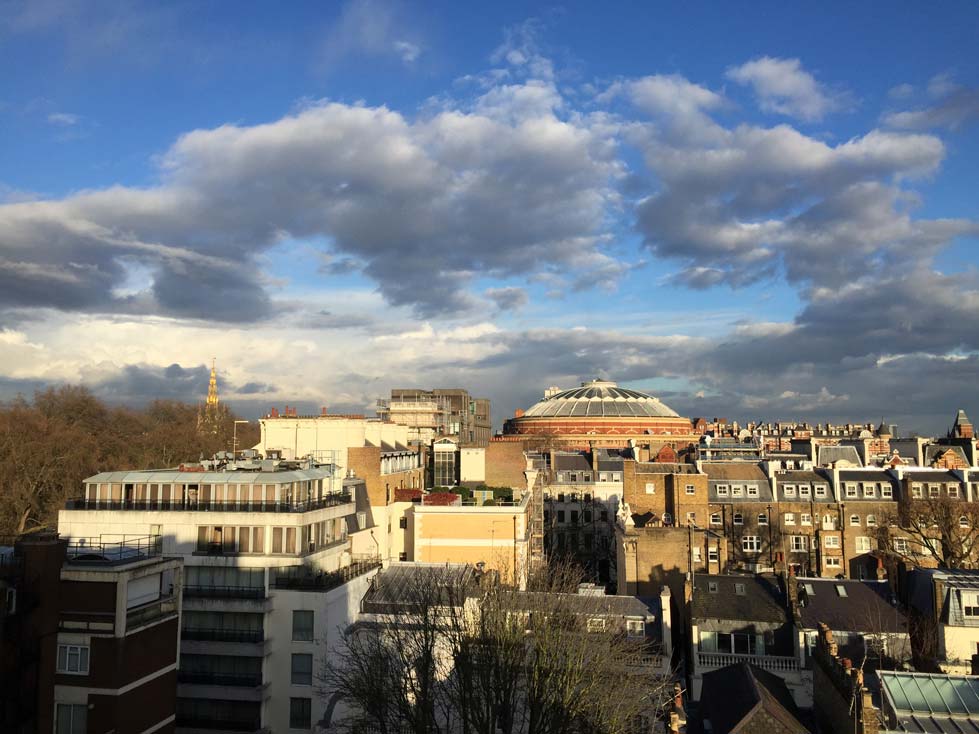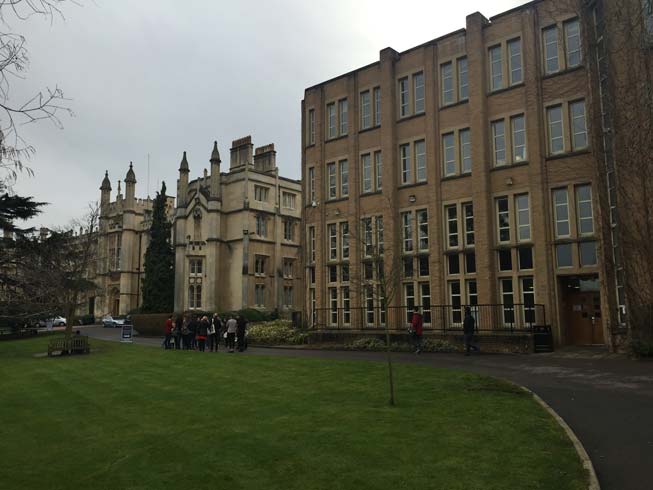CENTRAL ST MARTINS, UNIVERSITY OF THE ARTS
Central Saint Martins is one of the six constituent colleges of the University of the Arts London. UAL is Europe’s largest specialist university for art, design, fashion, communication and the performing arts, and currently educates 14,000 undergraduates (about two-thirds of the total), 2,700 postgraduate and research students, and 2,250 further education students. About 53% of the students are international.
Central St Martins, with its 4000 students and 1000 staff, moved to a glorious new landmark location in 2011, designed by architects Stanton Williams as part of a 67-acre redevelopment of King’s Cross.
I had the honor of spending three hours with Dr. Jo Wheeler, Head of International Development, responsible for exchange programs with universities throughout the world. CSM places a strong value on international partnerships. CSM strives to develop formal 1:1 exchange programs. Prime examples are SVA (School of Visual Arts) and Pratt in NYC for art, Carnegie Mellon in Pittsburgh for Drama. In addition, CSM students do Student Abroad and international students come to CSM. Parsons has a strong history of sending students to spend a term at CSM.
The features of the four-level open design can best be captured through photos.
Openness and transparency:
Workshops: Emphasis on “Making”
CSM does not offer Art History, because it is concerned with the development of new approaches. Architecture, for example, is intertwined with social issues such as the public use of space. Teddy Cruz, an architect and academic from UC Santa Cruz, is doing a “Practitioner Residence” at CSM; he studies the impact of border crossings on architectural innovation.
Group Work
Highly visible installation and performance art, seen from multiple perspectives:
Programs
CSM has 3-year BA programs in:
- Acting
- Architecture
- Ceramic Design
- Criticism, Communication and Curation (CCC)
- Directing
- Fashion
- Fine Art
- Graphic Design
- Jewellery Design
- Product Design
- Textile Design
2-year MA programs are available in:
- Communication Design
- Creative Practice for Narrative Environments
- Ceramics, Furniture or Jewellery
- Textile Futures
- Fashion
- Fine Art (1-year)
- Industrial Design
- Innovation Management
- Acting, Directing, Writing
Foundation Program
Many UK institutions offer a pre-University “foundation” program, in which students can satisfy the entrance requirements. For example, students may not have had access to rigorously sufficient art programs in which to learn basic approaches and develop a portfolio. Or, for academic courses of study, US students may be attending a high school that does not have offer AP or IB programs, and would therefore not be able to provide required entrance exam scores. In such situations, students can take a 1-year foundation program, and then apply. At CSM, there is an admissions advantage to taking the foundation program here, because professors become familiar with your approach and quality of work.
Interdisciplinary approach
CSM puts enormous stock in the benefits of interdisciplinary proximity in the open-ly constructed environment. As Jo says, “Fashion here is within an art context; it has to bounce off fine art and architecture.” Similarly, the Graphics Program is broad and not commercial: typography, advertising and the moving image are all together.
Fashion Program
CSM is renowned for its focus on fashion. Top designers have emerged from the program, including Stella McCartney, Alexander McQueen, John Galliano and many others. CSM is the only fashion school that exhibits at London Fashion Week, on the same stage as top international designers.
Fashion is the only program that prohibits visitors from taking photography because of the keen competition for new approaches. But I was permitted to walk through the long high-ceilinged, light-filled design rooms filled with bustling students and hundreds of mannequins being outfitted.
Admissions
In Jo’s words, “Here the benchmark is your portfolio, except for writing-based courses (such as Communications), where scores and writing samples are taken into account.” A key difference between what CSM seeks in a student’s portfolio versus a US school is that CSM is extremely interested in the development work that leads to the outcome, whereas the US art schools want portfolios to include finished work. At CSM, a portfolio could include 30 pieces, of many of which are the sketches and stages of one particular project. The work should show the ability to edit your work, and a clear visual aesthetic.
The Personal Statement plays a large role as well, and should have a rigorous focus. Students should discuss why they want to come to UAL, and CSM in particular, what they want to study, and how CSM will benefit them. In addition, discuss your work and who you’ve studying in developing your own artistic vision.
The SAT and AP scores, as well as references, play a secondary role. For each program, the minimum requirements are listed on the website.
National Gallery of Art
I visited the National Gallery the day after CSM. I had the pleasure of seeing the new Impressionism exhibit, providing a befitting contrast with the modern, cutting-edge approaches of CSM! The exhibit focused on the role of Paul Durand-Ruel, a nineteen century Parisian art dealer, in relentless supporting and promoting the works of a broad group of Impressionists, including Manet, Monet, Renoit, Sisley and Degas. While there was enormous critique and resistance in Europe, he finally found a receptive market in America.
Tuesday, March 3rd
Delighted to return to London yesterday. At night, I saw a gripping, profound drama at the storied Haymarket Theater called Taken At Midnight, set in Germany in the 1930s. Penelope Wilton (Lady Crawley in Downton Abbey) was spectacular and riveting.
Today I’m off to the University of Cambridge to meet with professors and further explore campus life. I spent a day last July visiting several of the constituent colleges, as well as summer programs. Stay tuned for further exploration of this historic university town.
Tuesday, March 3
I had the pleasure of returning to St Andrews last Thursday and Friday for an organized College Counselor tour.
As you may recall, last summer, I visited St Andrews on my own, and spent a lovely day becoming acquainted with this ancient university. For those of you who think I may be tossing around the world “ancient” arbitrarily, allow me to explain…
Classifications of UK Universities
The United Kingdom groups its universities into categories based on when they were founded. The most revered group is considered the “ancient universities,” consisting of the seven universities founded before 1800. I have now visited five, including Oxford and Cambridge in England; and St Andrews, University of Edinburgh and University of Glasgow in Scotland. The remaining two are Aberdeen (Scotland) and Dublin (Ireland). This group has been compared to the Ivy Leagues in the US because they are the most historic and perceived to have the strongest academics.
The remaining universities are divided into the following categories:
- London universities, including the vast University of London system, as well as Durham and the former University of Wales system
- Red brick universities, founded in the first few decades of the 20th century
- Plate glass universities, also known as the “new” universities, chartered after 1966
In addition, there is a self-selected association of 24 public research universities known as the Russell Group, which cuts across all the categories discussed above, and is made up of very large research-intensive universities. As a collective, the group receives most of the public research funding, and awards most of the Ph.Ds. The Russell Group consists of Queens University in Ireland, Edinburgh and Glasgow in Scotland, and 21 British universities, including Cambridge, Oxford, Durham, Imperial, Kings, LSE, University College and others.
2014 Visit to St Andrews
When I last visited St Andrews, I met with members of the international admissions team, had a delightful and informative lunch with Ivar Moller at A Doll’s House in town, enjoyed a comprehensive student tour, met with career services, and chatted with a Physics Professor. This visit provided an excellent introduction to the unique Scottish approach towards undergraduate education, as well as a comprehensive look at what makes St Andrews unique.
2015 Visit to St Andrews
In contrast to my 2014 visit, this trip to St Andrews was organized by the university, and allowed me to deepen my knowledge of academics, campus life, and institutional priorities. I was joined by about 40 high school guidance counselors and five other independent educational consultants.
Principal Louise Richardson
We were honored to be addressed by Louise Richardson, the first female Principal and Vice Chancellor of a Scottish university. Ms. Richardson also serves as Professor of International Relations with globally recognized expertise in terrorism. She formerly taught at Harvard and served as Executive Dean of the Radcliffe Institute of Advanced Studies. Currently Professor Richardson teaches an undergraduate seminar on terrorism to a small class of 12 students from different countries.
Principal Richardson’s descriptions of the unique identity of St Andrews was very similar to how you might hear Princeton and Yale described: “we combine the ethos of a small liberal arts college with the reality of a major research institution… We are the ideal size: big enough to be interesting, and small enough to have an influence on every life.”
Her institutional priorities are decidedly academic: “focus on good-quality research and personalized high-quality teaching.” Principal Richardson said she has an old-fashioned approach towards interdisciplinary study, in that “scholars need a strong grounding in separate disciplines first,” and then can explore interdisciplinary collaborations. Some of the new fields for St Andrews include International Legal Studies and War and Security, a combination of history, philosophy and international relations.
Admissions
The admissions team at St Andrews is exceptional. In addition to being warm and welcoming, whether on American or Scottish soil, they are extremely knowledgeable and articulate about the nuances of both admissions and academics. The team is headed by Julie Ramsey, Director of Admissions; Beth Shotton, Director of International Admissions, and Ivar Moller, Director of North American Admissions.

Beth Shotton, Director of International Admissions, biking through the Scottish highlands (in a Kansas t-shirt!).
The admissions process at St Andrews is holistic, and all components are reviewed. The most important factors are the transcript, AP exams, Subject Tests and SAT/ACT. The transcript is reviewed heavily, with more emphasis on 11th and 12th grade, and on courses that relate to your intended subject(s). The GPA is becoming less important, since the scales differ widely by secondary school. A competitive applicant would typically have an A- average in a high-quality college preparatory program, AP scores of 4s and 5s, and Subject Test scores over 600.
Admission requirements for individual subjects are clearly stated on the St Andrews website.
Unique Features of St Andrews
In addition to St Andrews’ top-quality research and teaching, here are a few unique features of the University:
- University and town are fully integrated
- 600 years of history and tradition
- Ocean and beaches are close at hand
- International exposure to a global student body, with 160 countries represented
US students in particular feel at home amidst the strong US presence. Americans are the #1 international group, followed by China, Canada and Hong Kong.
Although the university is relatively small, with 6,400 undergraduates, the philosophy is for students to develop their independence. Students do not receive session-by-session assignments, but instead know what is due for the entire course and must pace their work on their own. Dr. Chris Lusk, Director of Student Services, wants St Andrews’ students to develop “agency”: the qualities of being resilient and solution-focused.
Academics
The 4-year academic model of St Andrews includes:
- Years 1 and 2: “subhonours” work in which students take three subjects each year;
- Years 3 and 4: focus on either one subject, graduating with a single Honours degree, or two subjects, leading to a Joint Honours degree.

Ivar Mollar illustrates a 4-year academic sequence
The United States approach towards higher education had its foundation in the Scottish philosophy of combining broad liberal arts exposure with focused work. But the founders of the earliest universities in the US wanted students to have an even broader exposure to the full range of liberal arts disciplines throughout all four years.
The education at St Andrews is characterized by deep intellectual exploration, small classes with a premium on discussion, and a senior dissertation. We were fortunate to hear several talks by academics about their fields and departments.
Philosophy Professor Patrick Greenhough’s talk clearly demonstrated the engaged approach of the faculty at St Andrews. The Professor asked a series of probing questions, such as:
- What is philosophy?
- What is beauty?
- What is consciousness?
- What is a language?
- What is a person?
- Can war be just?
- Can you predict the stock market?
St Andrews’ Philosophy Department is considered one of the top in the UK, not only in research rankings, but Student Satisfaction Survey. (Watch for our upcoming blog on how universities are ranked in the UK!)In fact, the Philosophy Society at St Andrews is the largest society (extracurricular activity). What are some fields that philosophy grads can enter?
- Become a comic – Ricky Gervais
- Found a leading social media company, like Linked In or Wikipedia – George Soros
- Do groundbreaking linguistics research – Noam Chomsky
St Andrews has a popular joint program with the College of William and Mary, the second oldest college in the United States, in which you spend two years at each school. You can choose to apply to either St Andrews or W&M as your host college, and if accepted, you spend your first year at the host college, your second year at the other college, and then choose how to sequence your final two years. Four degree programs are offered as part of this joint degree: English Literature, Economics, History (which includes a large language component) and International Relations (the most popular subject for US students).
The sciences are housed in a separate modern complex, a 10-minute walk from the main campus.
Your Academic Family
St Andrews has a unique approach to providing peer support! During your first year, you will likely be approached by at least one “academic mother” and/or “academic father” who offer to “adopt” you. You will then de facto acquire a number of brothers and sisters, and possibly cousins. While I am using quotes in describing this system, the students involved do not in any way use air quotes, but instead earnestly share such personal details as “my mother and father are not married, in fact are married to other people, and I have eight brothers and sisters, some of whom have other parents”! The students derive an enormous sense of support from this long-standing tradition, especially since so many are international and a long way from home.
Residential Life
Freshmen are required to live in a hall of residence. There are ten halls, ranging from Victorian to modern style. Some are “catered” (providing food) and some are not. There are no specific floors or wings for segments of the population, such as international or LGBT, but there are plans to institute no-alcohol accommodations next year. Remember that the drinking age is 18!
One of the most popular halls is St. Salvatore’s, which has a very Hogwarts-ian feel and is centrally located.
Sally’s has 260 undergraduates, two-thirds of which are first year and one-third “returners.” Most students share a room, and first year students are carefully matched. This contrasts with University of Glasgow, which has all singles. The halls are run by a “Warden” and Assistant Warden, charged with providing social, emotional and academic support. The hall has a Committee of about 18 elected students, who run all the social activities and events.
Activities
But St Andrews is by means an exclusively academic experience. Students gain an enormous amount from their participation in “societies,” or extracurricular organizations. During our final evening, an a capella group serenaded us with their creative vocal artistry – singing a combination of moving ballads and quite humorous songs about romance. Later on, we were treated to Scottish Highlands dancing.
And then, it was time to say good-bye to the castle on the hill.
Monday, March 2
I have now completed my tours of the “ancient” Scottish universities of St Andrews and University of Glasgow, having also visited the University of Edinburgh last summer. Tomorrow I head back to London by train, with plans to spend Wednesday at Cambridge, and tour Royal Veterinary College and Central St Martins (University of the Arts) before I head back to the States.
My trip has been intense and comprehensive, stimulating and mind-expanding. The ratio of experience to reflection has been high! As a result, I have not yet blogged on all that I have observed and absorbed, and plan to use the lovely train ride tomorrow to catch up!
A few hints of blogs to come:
Sunday, March 1 – Dining in the UK!
Yes, I came all the way to Scotland to have a bagel and lox! Or, as they call it here…
Smoked salmon. You can have salmon morning (with scrambled eggs), noon (baked with aubergine) and night (raw with flowers). And I have.
But lest you think, gentle reader, that I am not a food explorer, here are some classic British dishes and where I had them.
“Dressed Crab” in London. Brits are so proper that even their appetizers need to be dressed. This classic dish is typically served with a dressing of dark crabmeat in the center, and chopped egg whites.
Herring and cream sauce at a French bistro near the Victoria & Albert Museum. As an island, Britain cannot be outdone for its variety of seafood.
Cullen Skink Soup in Glasgow. This native fish chowder was served at a popular restaurant in Glasgow called Two Fat Ladies!
“Fish ‘n chips” in St Andrews. You would lose all respect for me as a seasoned traveller, so to speak, if I did not include this classic dish. This is a half-portion of haddock (in England this dish would be made with cod), and a combination of “mushy peas” and small peas.
Dover Sole in London. At the other end of the seafood spectrum, while Daisy is eating fish ‘n chips, Lady Mary would dine on Dover Sole. This well-known seafood dish in England (and considered haute cuisine in the US) comes from Dover, a seaside town in Southeast England that faces France.
Sea Bream at The Vine Leaf in St Andrews. An amiable husband-wife team runs this small inventive restaurant on South Street, a few blocks from campus.
Toffee pudding. And if you’ve saved room for dessert, you will be offered toffee pudding nearly everywhere!
Wednesday, February 25
University College London was founded in 1826, making it the first university to be founded in the city of London, and the third in the UK, after Oxford and Cambridge.
In contrast with Oxbridge, UCL was founded on principles of inclusion by Jeremy Bentham, British philosopher, jurist and social reformer. Heads-up for a gruesome fact: Jeremy’s body is actually embalmed within his likeness in the central building of UCL (see below), and I myself stood but a foot away from a man who lived nearly two centuries ago!
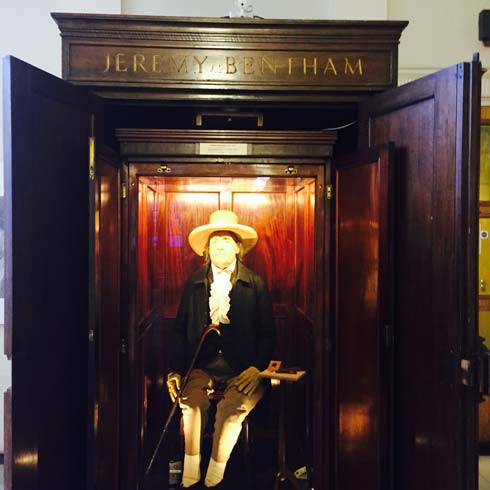
Bentham did not subscribe to the status quo. UCL welcomed students of all backgrounds, and was the first to admit women. While the founders of Oxbridge were monks, who placed the study of theology at its core, UCL is a secular institution and its library is physically located at its center. See the library dome below.
Most universities in London are affiliated with the umbrella organization of the University of London, which performs centralized functions such as finances and appointing professors. Over time, UCL has merged with several constituent colleges of University of London, such as the Institute of Education and the School of Pharmacy, and is now the largest college within the University of London system. U of L does not play a large role at present in UCL’s functioning, but provides a few convenient shared resources, such as libraries and intercollegiate housing.
ACADEMICS AT UCL
Bentham’s unconventional and creative approach fostered a spirit of intellectual exploration that continues to this day. UCL has many notable alumni, from Mahatma Ghandi to Alexander Graham Bell to Francis Crick (co-discover of DNA). But perhaps the most famous are the band members of Coldplay!
UCL prides itself on collaborative, interdisciplinary programs, including the new “Arts and Sciences” series of majors, which emphasize communication, problem-solving and global cultural skills. Within “Arts and Sciences” are four pathways: two humanities (Cultures and Societies) and two sciences (Health and Environment, and Sciences and Engineering). If you major in a humanities pathway, you must minor in a sciences pathway, and vice versa; these requirements are somewhat reminiscent of US distribution requirements, and are quite similar to MIT’s requirement that STEM majors must minor in an arts or humanities subject.
Some of the most popular and highly-regarded programs are law, medicine, economics, psychology, neuroscience and the biological sciences. Studying medicine effectively requires access to hospitals for clinic work, as well as strong research facilities. UCL recently built a new medical complex, including a hospital and the Wellcome building for research.

The former hospital, located in a magnificent historic building (below) is now used for biological research.
RANKINGS
In the UK, there are a variety of higher ed ranking systems, in contrast with the monolithic US News & World Reports for US universities. One of the most respected rankings is the REF (Research Excellence Framework). REF ranks overall institutions as well as individual subject areas. REF calculates a “GPA” from 1.0-4.0 that combines assessments of the institution’s research in terms of “output” and “impact.” “Output” is the quantitative assessment of the number of research publications at various levels of prestige, with 4.0 reflecting international stature; “Impact” is the qualitative measurement of the influence of the research on individuals, societies and policies.
UCL ranked #8 overall in the 2014 REF (with Institute of Cancer Research #1, Imperial College London #2, LSE #3, followed by Oxford, Cambridge, Cardiff and King’s College.) In the REF subject rankings, UCL ranked #1 in Computer Science, and Economics and Econometrics. A leading measurement in the UK is inclusion in the “Top 10” rankings for particular subjects, and of 36 subjects measured, UCL has a top-ten ranking in over half, ranging from Clinical Medicine to Law to Aeronautical Engineering to Politics.
Other organizations respected for their rankings of universities include Times Higher Education and the Guardian, two leading newspapers. The Times ranks UCL as #5 in Europe, and #22 in the world. The Guardian ranks it #11 in the UK.
STUDENT BODY
UCL has about 26,000 students, with a bit over half in the graduate programs. 40% are international (outside of the UK). China represents the largest country of origin, with 3,000 students; the US is second, with a combination of exchange, study abroad and full-time undergraduate degree students.
STUDY ABROAD
US students can study at UCL for a semester or full year through either a “study abroad” or “exchange” program. The Partners for Exchange program is based on reciprocity, in which equal numbers of students swap universities. Since US students typically study abroad for one semester, and UK students for one year, the US sends two students for every one UK student. Formal US partners include a range of institutions such as Columbia, Georgetown, Hopkins, Penn, UNC Chapel Hill, and the University of California system.
In contrast, the Study Abroad program does not require an equal exchange of students. Currently, there are 550 Study Abroad students from the US, including 80 for a full year, and the remainder for a semester. Princeton has a unique partnership with the UCL English department, in which US students take three UCL courses and one Princeton-led course on the London campus. A similar partnership exists with Tufts, and others may follow. The University of Chicago just changed from a study abroad to exchange partner.
By the way, NYU has adopted a different model, in which it invested heavily in numerous global centers around the world, with its own teaching staff; one of its most prominent programs is NYU-in-London.
UCL wants to encourage its own students to participate in study abroad as part of an institutional strategy of encouraging global citizenship. Currently 21% of undergraduates do study abroad, and the goal is to increase this involvement to 35%.
ADMISSIONS
UCL is one of the most prestigious and selective institutions in the UK, indeed in the world. Keep your eyes open for a future blog on rankings of UK institutions! UCL receives about 30,000 applications each year for 3,000 places.
By now, you are aware of the UK policy of requiring a specific number of APs with required minimum scores. At UCL, 5 APs are required, and individual programs range from 54444 (5 in one AP and 4 in 4 APs) to 55555 (5s in 5 APs). SAT Subject Test scores are not considered, and the SAT General Reasoning Test can be submitted as additional information, but offers will not be made conditional on the SAT. Of course, IBs or A-levels are acceptable as alternatives to APs. In addition the BMAT (UK version of MCAT) is required.
UCL offers a “foundational courses” for students who do not have the entrance qualifications. Its UPC (Undergraduate Preparatory Certificate) course includes two options, one for the humanities, and one for science and engineering. Students who wish to apply to any UK institution can take these courses at UCL.
So if your heart is set on attending a UK university, there’s always a way!
Tuesday, February 24
Imperial College
Just like in the US, each university in the UK has its own story. No two universities are the same, and each school’s story has its own central players.
For Imperial College, the catalyst was Prince Albert, Queen Victoria’s husband, who lived during the mid-nineteenth century. Albert was a pioneer in his devotion to STEM – science, technology, engineering and medicine. By royal charter, he established Imperial College, with the goal of pursuing these disciplines to the fullest extent possible. Albert would be very proud, since Imperial is now considered a world leader in the research and teaching of STEM.
ALBERTROPOLIS
To fully appreciate the scope of Albert’s reach, it’s helpful to grasp the concept of “Albertropolis” (an amalgam of Albert and metropolis), which refers to the swath of London created and inspired by Albert. The photo below was taken from the terrace of a business school classmate of mine. You can see the Albert Memorial in Hyde Park at the left, the domed Albert Hall (a major performance venue) in the center, and the Victoria & Albert Museum on the far right. Such is the scope of Albert’s influence!
In fact, the royal ties to Imperial run deep – Baby George (referring, of course, to William and Kate’s firstborn) was born in Imperial College Hospital, and most likely his sibling will be born there as well.
So if you come to live in London, you will no doubt end up becoming a touch more knowledgeable about England’s political players. You may honor her highness or you may mock the monarchy, but either way you’re not likely to respond to the question “So who’s the Queen now?” with a blank stare. (It’s Elizabeth, and she’s been Queen for so long that 12 Prime Ministers have come and gone.)
But we digress! On to the unique characteristics of Imperial…
ACADEMICS AT IMPERIAL
There are three “streams” of study at Imperial, and each has about one-third of the students: Engineering, Medicine and Natural Sciences.
Engineering is the largest of the three, in both number of courses and faculty. A new program, the Dyson School of Design Engineering, is funded by Jim Dyson and run in collaboration with the Royal College of Art. The mission is to design innovative products, and make them aesthetically pleasing as well. This is the only engineering course at Imperial that does not require physics. There is a lot of overlap with Imperial’s Bio-Engineering department, which recently created, designed and brought to market a Para-Olympic sporting equipment : the “ghost arm,” a glove that trains disabled athletes to initiate effective swimming movements.
Medicine is available as an undergraduate subject in UK universities – one of the many significant differences between UK and US undergraduate academia. At other UK universities, medicine is typically a five-year program. At Imperial, however, medicine is six years because of the addition of an “intercalated” 4th year, in which the student researches a specific medical field, such as immunity, infection, global health, or management, and receives a BSc. Students go into hospitals immediately in their first year, and receive a mixture of problem-based learning and lecturing during their first three years. Their final two years are purely clinical.
If an American student wanted to practice medicine back in the US after receiving a medicine degree from Imperial, he or she would need to pass the US medical boards.

Cutting-edge medical research is conducted at Imperial such as studies on effects and reconstruction for blast injuries.
WOMEN AT IMPERIAL
Imperial is a member of Athena Swan (Scientific Women’s Academic Network), a national UK initiative to strengthen the participation of women in STEMM, which encompasses the fields of science, technology, engineering, medicine and maths (the UK word for mathematics). The UK established the Athena Swan Charter in 1999 to advance STEMM, achieve gender equality, eliminate bias, increase management diversity and address challenges in doing so. Universities are eligible to receive a silver or bronze award, and individual departments are eligible for gold, silver or bronze awards, based on efforts to achieve these goals.
Imperial has a Silver institutional award, as well as thirteen departmental awards ranging from Bronze to Gold; Chemistry holds a Gold, and Chemical Engineering, Earth Science and Engineering, Materials, Physics, National Hearta and Lung Institute and Public Health hold a Silver.
You can search the websites of all UK universities for information on their commitment to the aims of Athena SWAN.
US STUDENTS AT IMPERIAL
The US represents the 12th largest student representation out of 26 countries, and most US students are in post-graduate study (Masters or PhD) as opposed to undergraduate study. Students can do a 1-year Study Abroad program from October-June as Visiting Students, and are fully integrated with the full-time student body. Most US students who participate in Study Abroad at Imperial do so in Engineering. An excellent way to experience Imperial is through The Global Summer School, a variety of pre-university programs.
ADMISSIONS
Let’s illustrate UCL’s approach to admissions by focusing on medicine.
Personal Statement. As you already know from our blog on UK admissions, the Personal Statement should focus on academics. The Imperial international recruitment staff suggests that 90% of the content involve academia, including topics such as influences on your desire to practice medicine, science research papers, related work and volunteer experience. Try to capture your observations – don’t just summarize the facts of your experience. For instance, if you shadowed a doctor examining patients, how did the injured person react? If you watched a surgery first-hand, what was the atmosphere like? What did you see and hear? The other 10% of the essay should focus on extracurriculars. You would benefit from focusing on qualities related to a medical career, such as leadership or ethical values.
Academic Performance. UK admissions typically does not consider a student’s high school GPA! I know this is shocking news! Instead, testing is evaluated as follows:
- Required:
- A minimum performance level on AP exams, IB courses or A-levels, depending on your school’s curricular system. For example, acceptance to Imperial’s Medicine program requires 3 AP exams with a score of 5, including Biology and Chemistry, and either Calculus BC or another science. For an IB curriculum, a minimum of 38 points is required, with 3 HL courses (High Level), 3 SL (Standard Level), and minimum scores of 6 in Biology and Chemistry and 5 in SL English
- BMAT exam (similar in function to the US MCAT for medical school).
- Interview. Interestingly, medicine is the only subject for which Imperial requires an interview, in order to assess interpersonal qualities of empathy and communication.
- Possibly considered but not required: SAT Subject Tests; these scores can be included either in the Personal Statement or through one of your references.
- Not considered at all: SAT General Reasoning Test.
Specific requirements for each academic program at each UK university are specified on the website. Some universities have not developed equivalence requirements for AP exams, since they are a uniquely American form of secondary school education; if you do not find such info on the website, contact the international admissions office.
Keep in mind that in the UK system, students can apply to a maximum of five university programs (one maximum in Oxford and Cambridge combined); and receive either a conditional or unconditional letter of acceptance. The conditional letter would specify the required AP, IB or A-level scores.
The UK university system offers unique features and benefits. Assess whether the UK approach and the specific features and culture of individual institutions are a good fit for you!
Blogs will be posted in the next few days on our recent visits to:
- Chelsea College of the Arts
- Kings College
- University College London
- SOAS (School of Oriental and Asian Studies)
- University of Roehampton
Next up: University of Durham and St Andrews!
Monday, February 23
What’s on today in London:
Imperial college, Victoria & Albert museum, Kings college London! (More coming soon!)
Saturday, February 21
What’s on today in London: Palaces, Parks, Plays and Pubs!
Weekends will be spent exploring the culture of the cities, and reporting on how US students might enjoy leisure time if they choose to study in the UK. You’ll hear all about parks, pubs and plays!
Friday, February 20
Today, I visited three very different universities: an arts college, a mid-sized university with four constituent colleges, and a private liberal arts university with dual degrees from the US and UK.
Richmond, The American International University in London
Richmond was founded in 1972 as a private institution, with the unique goal of offering a US-style four-year liberal arts curriculum. With 1035 undergraduates, the school has a cozy, personal feel. Academic programs are divided into the School of Communications, Arts & Social Science; and the School of Business & Economics.
Whenever I visit a college, I try to answer these questions: What is unique about this college? How does it differ from comparable colleges? What kind of student would thrive and succeed here? I speak with admissions officers, faculty and students to get all different perspectives. I recommend this approach for prospective applicants as well, in order to assess your fit with each college.
Why Do Students Choose Richmond?
I approached various students and asked them why they chose to attend Richmond. Here are their responses:
- I wanted to study a variety of subjects in a liberal arts environment – I wasn’t ready to choose a major yet! At Richmond, you can take a variety of courses in 1st and 2nd years, and then must focus on your major for your 3rd and 4th years.
- I like having degrees from both the US and UK, which gives me more flexibility for grad school or work. Richmond is accredited by Middle States Commission on Higher Education in the US, and is validated by the Open University Validation Services in the UK. Richmond is in the process of acquiring its own degree-awarding powers.
- I wanted to be in London. Richmond has two campuses in greater London; one in Richmond, about 30 minutes from the center of London; and one in Kensington, in the heart of London. Students spend their first two years in Richmond and their 3rd and 4th years in Kensington. Adjacent to the university is Richmond Park, inhabited by deer.
- I liked the international flavor. 40% of the students are from the US, and the rest from all over the world. Students can spend a semester in Florence or Rome, and Shanghai will soon be an option as well. About six co-curricular trips to the UK and international venues are arranged each semester – next stop will be Iceland!
- I wanted to study International Relations. IR is Richmond’s most popular major, and is housed in the Politics and International Relations department. IR students often minor in Politics, and vice versa, because of the overlap in content. But while Politics has more emphasis on political science and the workings of the government, IR has a strong focus on diplomacy, global governance, human rights law and international law. IR grads go on to study at top colleges such as Oxford, Cambridge, LSE, Harvard, Cornell, MIT-Sloan and Penn-Wharton.
- Richmond is less expensive than US colleges. Tuition for international students is L14,500 (about $23,000), and room and board are L8100 (about $13,000).
- I wanted a small school, with close relationships with faculty. Richmond has an average class size of 17 students. Its facilities are small-scale and accessible as well.

 The Provost of Richmond points to additional strengths of the university.
The Provost of Richmond points to additional strengths of the university.
- Career Emphasis. There is a focus on careers from Day 1. Internships are strongly encouraged, and available to students with a 3.5 GPA. Richmond has established internship programs in London, Dublin, Barcelona, Beijing, Shanghai, Argentina, Cape Town and India.
- Service Learning. Richmond provides opportunities for academically accredited learning through volunteering.
- Global Citizenship. Richmond participates in a variety of study abroad and exchange programs.
Admissions
Students can apply to Richmond through UCAS (UK’s Universal College Application Service), the Common App, or Richmond’s direct online application. The Personal Statement should address questions of why you’ve chosen a particular subject area, why you want a liberal arts environment, and why you are specifically drawn to Richmond. In this way, the Personal Statement is a blend of the UK Personal Statement, which is very academically focused; and the US supplemental “match” essay that asks why you want to attend the particular college. Admissions decisions receive a 1-3 week turnaround.
Stay tuned for tomorrow’s discussion of my visits to Chelsea College of the Arts and the University of Roehampton!
Friday, February 20th
What’s On Today in London:
- Chelsea College of the Arts, University of the Arts London
- Richmond The American International University in London
- University of Roehampton
- Theater: The Nether
Day 2 promises to be action-packed with a full itinerary! Three very different universities, followed by theater in the evening. Stay tuned!
DAY ONE: Thursday, February 19
The London School of Hygiene and Tropical Medicine is one of the most important graduate institutions in the world for public health research and advocacy. The motto is “improving health worldwide,” and faculty are particularly known for playing critical roles in identifying and treating infectious diseases such as Ebola and HIV.
LSH includes faculties in three areas:
- Epidemiology and Population Health
- Infectious and Tropical Diseases
- Public Health and Policy
The Masters of Science (MSc) program admits about 650 students each year, and the most popular program is public health, with about 200 students. The university also offers a variety of specialized, interdisciplinary programs, such as Health Policy, Planning and Financing, a very popular and very competitive joint program with the London School of Economics. The Tropical Medicine and International Health program is the only one that requires a medical degree to enter.
Students take two semesters of courses, the first with required coursework and the second with electives. In addition, all students are required to do a summer project that can take the form of a systematic literature review, policy analysis report, short primary research project or secondary data analysis.
Each student has a “tutor” who supervises the summer project and acts as a mentor and support. A distinguishing characteristic of LSH is the importance of the close relationships between faculty and students. LSH runs weekly exhibits in which students can share academic work, such as this poster board of the potential effects of mosquitoes.
The fact that the program is only 1-year long is a draw for many US students, who comprise almost 10% of the student body. The program is also notable for its diversity, drawing students from 80 countries. Most students have several years of prior work experience, and share their perspectives. In fact, the MPIH program requires at least two years of experience working in a lower income country.
LSH has its own application, and does not accept UCAS. An important component is the 500 word Motivational Statement, in which students should describe how they have spent the last few years, why they are interested in their particular academic program at LSH, and how they will use the education at LSH to advance their goals.
LSH was created in an art deco style, and has magnificent interior courtyards. At the same time, it’s clearly an urban campus, and shares quads with other constituent colleges of the University of London system.
First evening in London? I head over to Ronnie Scott’s, the best jazz place in London. Like Jazz Standard in Manhattan, it’s an intimate space in the basement. Arturo Sandoval delights with an electric keyboard, drums and mostly trumpet (for which he won 10 Grammys), and plays a thrilling set with his band of a pianist, two guitarists and two drummers.
Thursday, February 19
What’s On Today in London:
- London School of Hygiene and Tropical Medicine
- Jazz at Ronnie Scott’s
I have arrived at The Stafford Hotel, a cozy hotel just steps away from Hyde Park, Green Park and St. James Park! Prince Charles lives a few blocks away, on The Mall, near Buckingham Place. Regent’s Park is due North, and the Thames River winds around to the south. Most importantly, I am centrally located for my rounds of university visits.
As I ease into the time zone (5 hours ahead of New York), I’ve planned a relatively low-key day, with a visit to the London School of Hygiene and Tropical Medicine (LSHTM) in the afternoon, and a return trip in the evening to Ronnie Scott’s, the top jazz venue in London. Stay tuned!
Wednesday, February 18 – Departure!
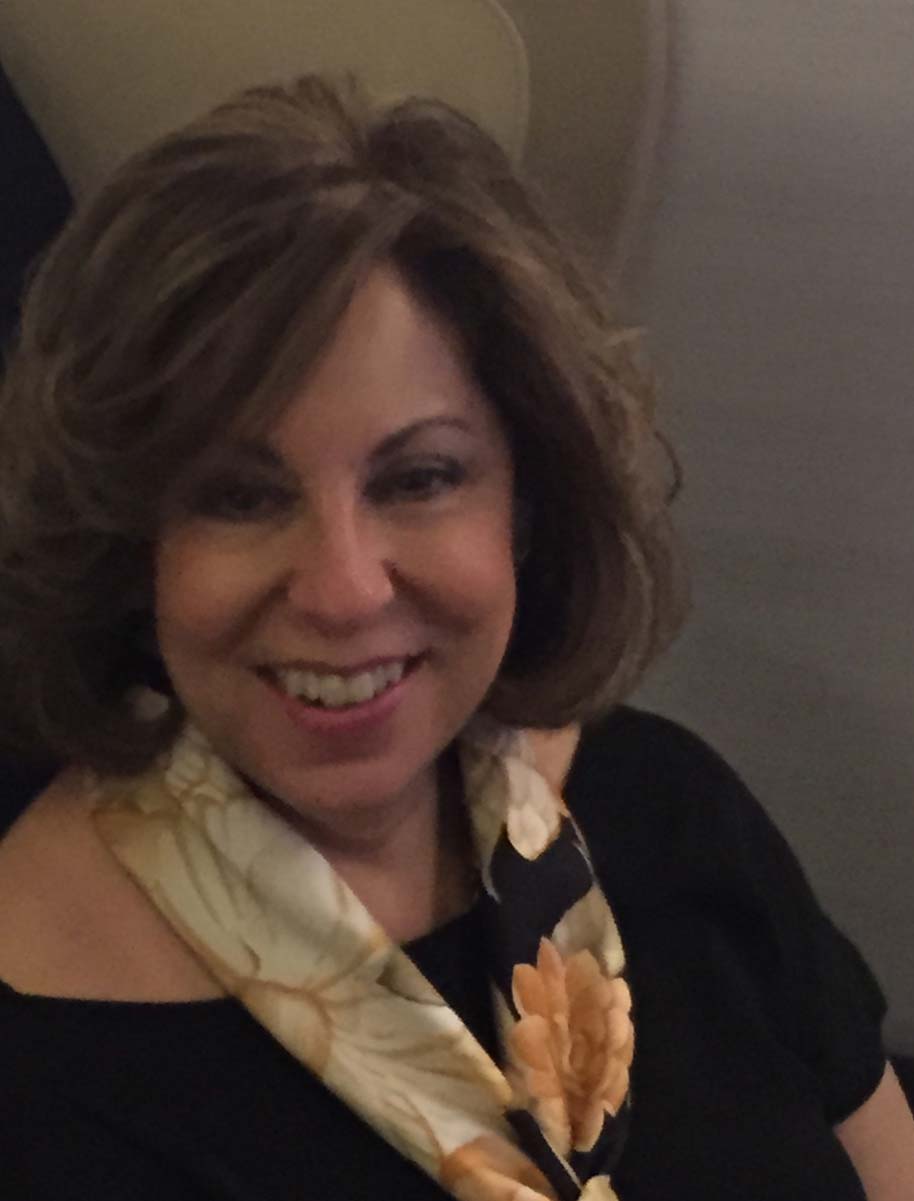
On the plane, about to take off!
I’m off! And with only my one carry-on for an 18 day-trip! I’ve learned from wise travelers and onebag.com that there are two types of luggage – carry-on and lost!
My plan is to visit universities in London from tomorrow through Tuesday. After that, I’ll travel by train to Scotland and visit University of Durham on the way north, spending two days at St Andrews and two days at University of Glasgow. I’ll then train it back to London (with a stop-over at University of Manchester), and conclude with visits to additional London schools and a return trip to Cambridge!
That’s 15 universities in all, ranging from ancient to modern, from the art schools to vet schools, to public health and large multidisciplinary research universities.


